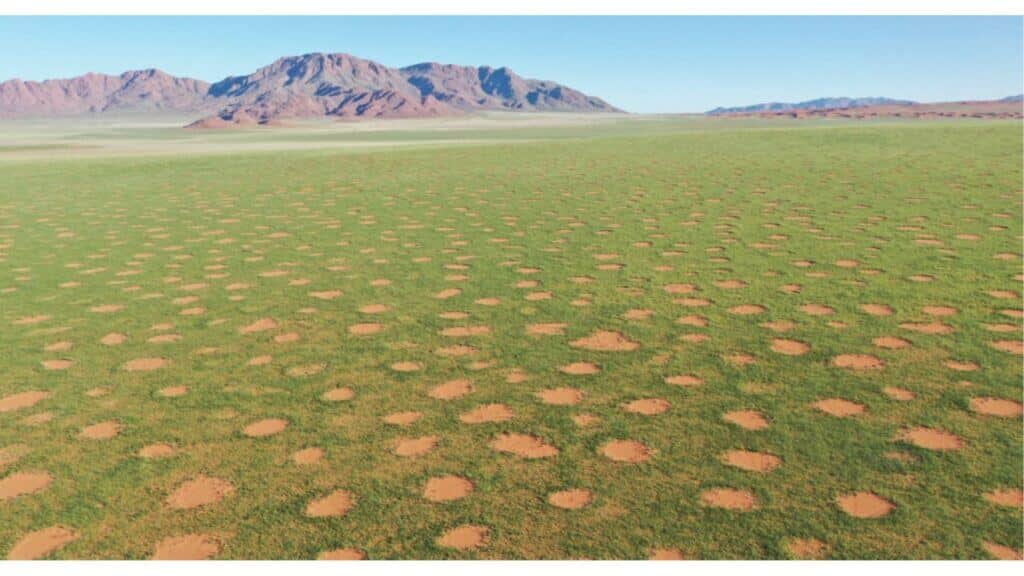Integrating coping mechanisms of ecosystems makes it possible to deal with drought conditions

Climate change and the development of dry climate conditions threaten ecosystems and the services they provide to humans. Research led by Prof. Ehud Miron from Ben-Gurion University of the Negev analyzes the mysterious plant patterns known as "fairy circles" and reveals the key to the resilience of ecosystems in drought conditions.
Plants are characterized by a high ability to adapt to changing environments, by changing their properties. This phenomenon known as "phenotypic adaptation" allows a single plant to cope with environmental stress such as a severe lack of water. A large population of plants has another mechanism to deal with water stress: self-organization in space by way of partial mortality of the population. "Fairy circles" are a fascinating example of this type of organization where plant mortality is limited to an orderly array of bare ground circles. These circles serve as an additional source of water for the neighboring plants and thus improve the system's durability in the water trough.
What is the question? How does nature learn to adapt to dry conditions? And what can be learned from this process?
The existing theory of vegetation patterns, based on the analysis of mathematical models and empirical observations, predicts the appearance of bare soil circles in vegetation surfaces in an orderly hexagonal pattern ("hole pattern") with the development of dry conditions. This prediction explains the formation of the fairy circles and their spatial organization, so that each circle is surrounded by an average of six neighboring circles. The existing knowledge in the field predicts, in addition, that the aggravation of the dry conditions will lead to the merging of the bare soil circles into a pattern of vegetation strips and strips of bare soil alternately ("stripe pattern"), and subsequently to the breaking of the vegetation strips and the creation of a pattern of vegetation circles on bare soil ("dot pattern"). Patterns of stripes and dots have indeed been observed in different parts of the world, but not in fairy circles. When the amount of precipitation is small, the hole pattern of fairy circles is preserved, but next to it another pattern appears: the vegetation cover between the circles is no longer full and in its place there appears a dot pattern of vegetation circles that are very small in size compared to the fairy circles. The result is a sort of multiscale pattern, characterized by two different length scales. Fairy circles in Namibia in the rainy season. Photo: Dr. Stefan Getzin.
Prof. Ehud Miron from Ben-Gurion University of the Negev, together with the post-doctoral students Dr. Jamie Bennett, Dr. Bidash Bara and Dr. Michel Pera, and in collaboration with Prof. Hezi Yitzhak and Dr. Stefan Getzin, offer an innovative explanation for the behavior This unique feature of the fairy circles phenomenon: a combination of phenotypic adaptation at the level of the individual plant, by way of deepening the roots of the plants into more moist and compact soil layers, and of self-organization in space at the population level.
Using a mathematical model that for the first time combines these two types of response, Prof. Miron and his research partners were able to solve the puzzle of the lack of streaks and dots along the rainfall, and the appearance of a multi-scale pattern. The appearance of the pattern of the small plant circles next to the large fairy circles is a result of the more compact soil layer that the deep-rooted plants experience.
The researchers, who won a research grant from the National Science Foundation, found that the combination of phenotypic adaptation and the creation of spatial patterns significantly improves the system's resistance to extreme drought conditions, compared to the resistance provided by each type of response separately. The study of fairy circles illustrates the need to expand the existing knowledge of plant patterns by taking into account possible changes in plant properties, and weighing the importance of such an expansion in obtaining a more reliable estimate of the resistance of ecosystems to environmental pressures.
The fairy circles in Namibia express one scenario of combining these reaction types, but the model reveals the possibility of additional reaction pathways leading to other multi-scale patterns which are also characterized by high resistance.
The fairy circles in Namibia express one scenario of combining these reaction types, but the model reveals the possibility of additional reaction pathways leading to other multi-scale patterns which are also characterized by high resistance. These findings suggest that ecosystems have a variety of alternative response pathways characterized by different resistance to environmental stresses.
"Understanding the complex response of ecosystems to a dry climate may provide clues on how to improve their resilience by identifying the response pathways that are characterized by high resistance, and diverting ecosystems at risk to these resilience pathways," Prof. Miron concludes.
Life itself:
Prof. Ehud Miron, married to Liora, father of a daughter and a son, grandfather of four granddaughters. "I have been connected to science and art since the age of 15, when my painter mother vacated half of her studio for a home chemistry laboratory that I set up. Etched in my memories is the experiment of producing hydrogen through the electrolysis of water, and igniting it - an 'explosion' experiment, literally. Science - in action, and art - in observation, have been integrated in my life ever since. Challenging intellectual activity alongside a liberating unmediated experience. Other than that, I'm a jazz fan and like to read. Attracted, among other things, to literature with surrealist elements such as the books of Jose Saramago and Rockie Murakami. Not a believer but not an atheist either. A fan of Maccabi Haifa".
More of the topic in Hayadan:
